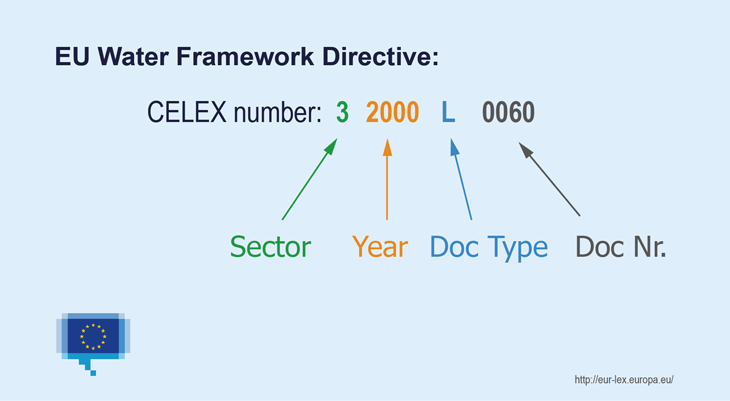CELEX
Most documents in EUR-Lex – regardless of the language they are written in – are assigned a CELEX number, which is a unique identifier.
Learning how to read these numbers will help you search faster and understand how documents relate to each other.
There are 4 parts to a CELEX number:

Sector
Documents in EUR-Lex fall into one of 12 sectors.
| Sector | Type |
|---|---|
| 1 | Treaties |
| 2 | International agreements |
| 3 | Legal acts |
| 4 | Complementary legislation |
| 5 | Preparatory documents |
| 6 | EU case-law |
| 7 | National transposition |
| 8 | References to national case-law concerning EU law |
| 9 | Parliamentary questions |
| 0 | Consolidated texts |
| C | Other documents published in the Official Journal C series |
| E | EFTA documents |
Year
The year of the CELEX describes the year of the publication, official number, internal number, etc.
In most cases, it is linked to the document number.
Document type
Each document type has a descriptor.
Descriptors can have 1 or 2 letters.
Some common descriptors
Sector 3 - Legal acts
- L for Directives
- R for Regulations
- D for Decisions
Sector 5 - Preparatory documents
- PC for Legislative proposals by the Commission (COM documents), etc.
- DC for other COM documents (green and white papers, communications, reports...)
- SC for SWD documents (staff working documents, impact assessments...)
- JC for JOIN documents (adopted jointly by the Commission and the High Representative)
Sector 6 - EU case-law
- CJ for Judgments by Court of Justice
- CC for Opinions of the advocate-general
- CO for Orders of the Court of Justice
Document number
Most CELEX numbers end in 4 digits. These reflect different types of information, e.g.:
Official number - 32017R2394. This is a sequential number showing when the document was published in the Official Journal. It is assigned by the Publications Office.
Internal number - 52018PC0033. This is assigned by the author of the document, the Commission in this case.
Date of publication - 32012A0424(01). This shows the month and day of publication in the Official Journal. It is followed by a sequential number in brackets, as other similar CELEX numbers might have been published on the same day.
Examples
Treaties (sector 1)
There are 3 digits after the descriptor.
They indicate the number of an article of the Treaty.
For example:
11957E086 is the number for Article 86 of the EEC treaty (1957).
Consolidated versions of treaties
These are indicated by the year of consolidation, e.g.
Treaty on the Functioning of the European Union:
12016E – table of contents, consolidated version 2016
12016E/TXT – consolidated version 2016
12016E003 – Article 3, consolidated version 2016.
International agreements (sector 2)
These agreements are identified by their publication date.
So the international agreement 22006A1230(03) was published in the Official Journal on 30 December 2006.
If several agreements are published on the same day, only the number in brackets changes: e.g. 22006A1230 (01)
Case-law (sector 6)
The document number is based on the case number issued by the Court of Justice.
The year is the year in which the case entered the Court’s register.
For example:
6 2004 TJ0 201
This is the judgment in the 201st case entered in the register in 2004.
The case number is T-201/04.
Corrigenda
Corrigenda have the same number as the document they are correcting, with R(xx) added at the end (xx being the number of the corrigendum).
For example:
32009L0164R( 01 ) is the first corrigendum to Directive 32009L0164 .
A corrigendum may relate to one or more language versions – or even all of them.
Consolidated texts (sector 0)
Consolidated texts have the same number as the basic act – but their sector is ‘0’.
It is followed by the date of application of the last amendment to the act (see our FAQ on consolidation). For example: 02009L0156- 20161018 .
Help Home FTS Apollo™ Help RegLens® Help